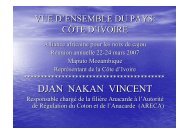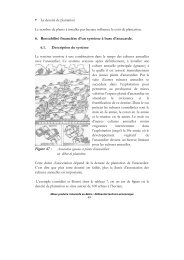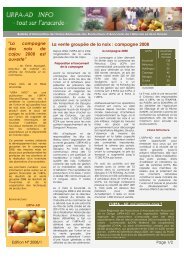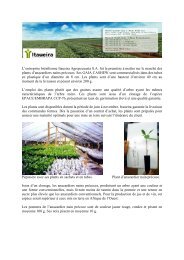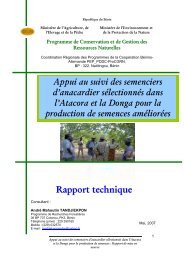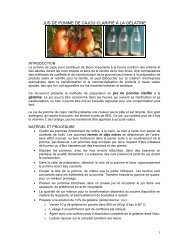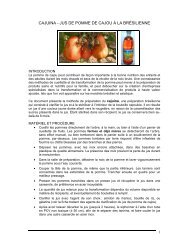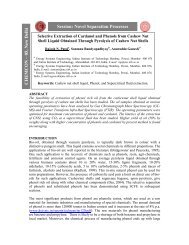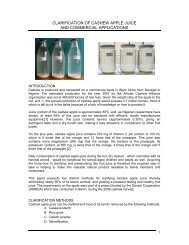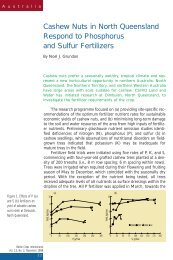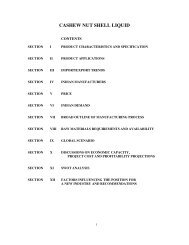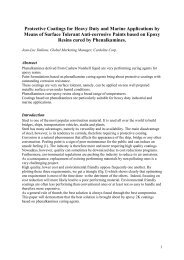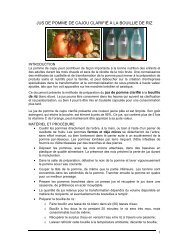Osmotic Blistering
Osmotic Blistering
Osmotic Blistering
You also want an ePaper? Increase the reach of your titles
YUMPU automatically turns print PDFs into web optimized ePapers that Google loves.
CARDANOL CHEMICALS N.V.<br />
International distributor of Cardolite Corporation<br />
Offerlaan 116-118<br />
B-9000 Gent<br />
Belgium<br />
<strong>Osmotic</strong> <strong>Blistering</strong><br />
By:<br />
Nit BaetsM, Cardanol Chemicals<br />
Summary:<br />
<strong>Osmotic</strong> blistering is a regular seen<br />
phenomenon when humid concrete is<br />
coated. This article describes shortly the<br />
most important parameters involved.<br />
Suggestions are made to decrease the risk<br />
of blistering, followed by an accelerated<br />
test method. We prove that by anticipating<br />
on the physico-chemical aspects of this<br />
natural behaviour we were able to<br />
overcome the repelling effect of the water.<br />
Introduction:<br />
The osmotic effect installs itself in<br />
presence of a semi-permeable membrane, a<br />
diluent - in our case water -, constituent(s)<br />
for which the membrane are not permeable<br />
and concentration differences. If one of<br />
these preconditions is missing there no<br />
such thing as osmosis.<br />
1) Adhesion:<br />
The adhesion of the primer is the most<br />
important parameter in the development of<br />
blisters. A well-penetrated and good<br />
adhering primer is very likely to course<br />
trouble.<br />
2) Semi-permeable membrane:<br />
The semi-permeable membrane can be<br />
situated at different levels. The upper part<br />
of the concrete substrate may act as one<br />
because of carbonatation in the pores,<br />
penetration of the primer, pore size<br />
distribution depending on the type of<br />
concrete or a concentration of high<br />
molecular admixtures who migrated to the<br />
surface during the cure of the concrete. The<br />
sizes of the pores and the pore distribution<br />
induce a capirarity in all cases.<br />
CARLIOLITE<br />
ARTICLES<br />
The mimer or other layers of the coating<br />
may act as well as a membrane. The<br />
chemical composition of the layers defines<br />
its susceptibility towards this phenomenon.<br />
3) Blister-fluid:<br />
Analyses of the blister-fluids indicated the<br />
presence of organic and inorganic<br />
constituents:<br />
0 Inorganic constituents are mainly salts<br />
coming from the mineral substrate.<br />
• Organic substances are related to the<br />
primer. These can be flexibilisers as<br />
Benzylalcohol, accelerators as<br />
Nonylphenol or solvents.<br />
Not all molecules have the same influence<br />
in the osmotic effect; larger molecules<br />
have a smaller influence on the pressure.<br />
4) Stability of the constituents:<br />
In case constituents of the primer react<br />
with the mineral substrate, decomposition<br />
materials are formed which take part in the<br />
osmotic effect (Ref.: 1,2, 3).<br />
5) Pre-treatment and application:<br />
Assuring a good adhesion starts with a<br />
proper pre-treatment of the concrete<br />
substrate. The pre-treatment necessary<br />
depends on the state of the concrete and the<br />
desired status before application.<br />
When a two component system is not<br />
properly blended, we may find amines.<br />
Improper blending is mostly accorded by<br />
local differences in mechanical properties,<br />
which turn these spots in to preferential<br />
areas of delimitation.<br />
Reducing the risk of osmotic blistering:<br />
The risk of delimitation of the coating is<br />
minimised when:<br />
Date issued:<br />
Document #:<br />
1999.05<br />
c-5.51/1/B<br />
Article regarding NC 558<br />
Revision:<br />
0
CARDANOL CHEMICALS N.V.<br />
International distributor of Cardolite Corporation<br />
Offerlaan 116-118<br />
B-9000 Gent<br />
Belgium<br />
• the pre-treated carried out properly<br />
• the application is made in the right way<br />
• the primer is solvent free<br />
The coating is for most paint companies<br />
the only parameter in control. We have to<br />
make sure that the primer is not subject of<br />
blistering:<br />
• Adhesion: The most important factor is<br />
the adhesion on the substrate. A low<br />
viscous primer that spreads out well<br />
and penetrates the concrete profound is<br />
less likely to provoke blisters.<br />
• Flexibility: The flexibility is not only<br />
of importance in regard to the final use<br />
of the coating. The flexibility and the<br />
influence of temperature changes<br />
correlates directly with the visual<br />
aspect of blisters.<br />
• Water soluble constituents: Research<br />
has proven that humid concrete<br />
substrates coated with a solvent free<br />
primer - and preserved under humid<br />
conditions - stay free of blister even<br />
after several years (Ref.: 4, 5). Solvent<br />
containing primers provoked blisters<br />
under the same conditions (Ref.: 6).<br />
The primer is stable under alkali<br />
conditions and has no water dilutable<br />
decomposition products.<br />
Primer formulation:<br />
We developed a concrete primer<br />
complying too the above guidelines, A low<br />
viscous Bisphenol A resin diluted with a<br />
Constituents Primer 1 Primer 2<br />
Part A<br />
Bisphenol A (Eurepox 80 80<br />
730)<br />
Necires EPXL-2 20 20<br />
Part B<br />
Cardolite@ NC 558 50 50<br />
Euredur 13 0 2<br />
DFT (CL) 300 300<br />
CARDOLITE<br />
ARTICLES<br />
Article regarding NC 558<br />
hydrocarbon resin is used as A component.<br />
Cardolitb NC 558, a low viscous<br />
Phenalkamine hardener, cross-links the<br />
system. Euredur 13 is used to adjust the<br />
cure at lower temperatures (5”C/95%<br />
R.H.). The primer is applied at 300~ film<br />
thickness.<br />
Necirez EPXL-2 is a non-reactive<br />
flexibiliser but contains aromatic OHgroups<br />
that bound in the hydrocarbon resin<br />
to the rest of the primer. The dense crosslinking<br />
obtained with Cardolite@ NC 558<br />
further minimises migration of the<br />
flexibiliser. The concentration of<br />
accelerator is kept limited hence its<br />
influence on the flexibility and<br />
hydrophobicity of the primer. The water<br />
vapour transmission rate of this primer is<br />
extremely low (1.33 lo-” mih) and assures<br />
a complete seal off the substrate.<br />
Two types of humid concrete are used as<br />
substrate:<br />
• High performance concrete: The high<br />
performance concrete (62 N/mm2) is<br />
since its dense structure subject of an<br />
increased capillarity and a less<br />
profound penetration.<br />
• Regular concrete: Concrete with<br />
compression strength of 30 N/mm* is<br />
more accessible for the epoxy primer<br />
but may contain more water.<br />
Accelerated test method:<br />
Sandblasted concrete tiles, of which the<br />
four edges are primed, are totally<br />
submerged for 2 weeks in water. Three to<br />
four hours prior to the application of the<br />
primer they are taken out and dried with a<br />
cloth. The water content of the substrate<br />
varies between 5.5% and 6.8%, depending<br />
on the type of concrete.<br />
Date issued: 1999.05<br />
Document #:<br />
C-5.51/2/B<br />
Revision: 0
CARDANOL CHEMICALS N.V.<br />
International distributor of Cardolite Corporation<br />
Offerlaan 116-118<br />
B-9000 Gent<br />
Belgium<br />
The tiles are partially submerged in water<br />
directly after application and are exposed<br />
to IR-light (150 W) during 8 hours a day.<br />
The primed surface reaches a temperature<br />
of 38 “C during radiation. This heat<br />
fluctuation of about 20 “C accelerates the<br />
osmosis.<br />
In this stage, it would be premature stating<br />
this primer to be the overall solution. A<br />
record of accomplishment of field<br />
applications needs to be set out to support<br />
our results, it is however looking<br />
promising.<br />
References:<br />
1: Wisser, S.: Verhalten van liisemittelfieien Epoxidharz-<br />
Systemen auf wassersaugenden betontichen. In:<br />
Kunstharz Nachtichten, 41<br />
2: Missfeld, H . : Zur Wechselwirking zwichen<br />
betonuntergrund und Beschichtungen. In: Bauforschung<br />
Baupraxis, 171<br />
3: Ettel, W.-P.; Ablner, M.: Blasenbildungen bei<br />
Epoxiedharzbeschichtungen und Ihre Ursachen. I N :<br />
Baustofflndustrie 22, Nr 6<br />
4: Sasse, H.R.; Littmann, K.: Entwickhmg van<br />
Anforderungs Kriterien f% d i e Dauerhaftigkeit van<br />
Fahrbahnabdichhmgen in Trog- und Tunnelbauwerktxv<br />
Forschungsbericht F 345. “on Instituut fiir Bauforschung,<br />
Aachen.<br />
5: Lithnann, K: Beschichtung van jungem beton mit<br />
Epoxidharzen nach den TL-BEL-EP. Im vorliegendes<br />
Tagungsband.<br />
6: Feibrich, M.: Kunststoftbeschichtungen auf stidig<br />
durchfeuchtetem beton. Forschungsbericht Nr F 184 van<br />
das Instutut fiir Bauforschung der RWTH Aachen<br />
Each primer is applied on both concrete<br />
substrates and exposed for 3 months. The<br />
primers showed no single osmotic<br />
blistering.<br />
Conclusion:<br />
Lab results have proven that a low viscous,<br />
truly solvent free, well adhering concrete<br />
primer enables to overcome osmotic<br />
blistering under the given circumstances.<br />
We hereby confirm the out come of the<br />
number of researches done in this delicate<br />
field.<br />
CAFDOLITE Date issued: 1999.05<br />
ARTICLES Document #: c-5.51/3/B<br />
Article regarding NC 558 Revision: 0




